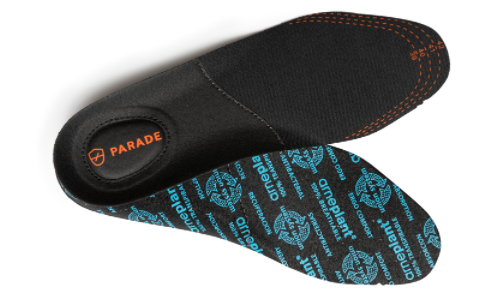Practical advice & expertise
SAFETY SHOE COMPONENTS
At first glance, you might think that a safety shoe is just a shoe, but think again. Safety shoes are made up of components, each more technical than the last, with different roles to play: safety, comfort, robustness and aesthetics.
Let's break down all the components of safety shoes to find out what they do.

Cross-section of a PARADE safety shoe:

1. The upper:
The part of the shoe that covers the foot is called the "upper". The upper can be made from a variety of materials, including leather (full-grain, split, nubuck, oiled, etc.), microfibre, fabric and many others.
The choice of upper components depends on the shoe's use, for example, resistance to liquids, breathability and ease of cleaning. But it also depends on the additional labels and requirements to which the shoe must comply.
For more information on the properties of each material click here
1a The lining
The lining is the inner part of the shoe, in direct contact with the wearer's foot.
This lining has a number of different roles: firstly, it provides a comfortable fit for the foot in the shoe, and secondly, it breathes and absorbs perspiration. Feet are one of the parts of the body that perspire the most. Wearing safety shoes, combined with physical activity, intensifies perspiration. And yes, over the course of a day, your feet perspire between 150 to 200ml per foot - that's the equivalent of a glass of water! That's why a lining with absorbent and breathable properties will help regulate moisture and keep your feet more comfortable.
For more information on the breathability of safety footwear click here
1b Collar and tongue
The tongue is a strip that can be made of different materials. It is attached at one end. Its role is to hold the shoe on the wearer's foot and protect it from the imprint of the laces. It also adds comfort to the instep, as it is often foamed.
A gusset is when the tongue is fixed on 3 sides and takes the shape of a triangle. The gusset serves several purposes: firstly, it prevents soil or water from entering the shoe and secondly, it secures the tongue so that it does not twist on the wearer's foot.
The collar is located at the back of the foot on the upper part of the shaft of the shoe. It provides support and comfort because it is often made from soft, padded materials. The size of the collar depends on the height of the shoe's shaft.
1c Shoe fastening
Our safety footwear comes with a range of fastening systems including laces, Velcro and zips. The purpose of these systems is to effectively hold the foot in the shoe and prevent foreign bodies from entering.
The laces and Velcro allow the user to adjust the fit to suit their needs and/or the shape of their feet.
2. Protective toe cap or protective shell:
The protective toe cap is at the front of the shoe. Its primary function is to protect the toes from falling objects (impact) and crushing (e.g. being run over by a piece of site equipment).
Whatever the shoe description (S1, S1P, S2, S3) or type of toe cap (steel, composite, aluminium, carbon, etc.), the requirements of standard EN ISO 20345 are always the same: they must all meet the same resistance threshold (impact resistance for 200 joules of energy). The protective toe cap is one of the key components in a safety shoe. This is what differentiates safety shoes (EN ISO 20345) from work shoes without toecaps (EN ISO 20347), or even from simple everyday shoes.
It should be noted that protective footwear (standard EN ISO 20346) also has a toe cap, but this is resistant to 100 joules, compared with 200 joules for the protective toe cap on safety footwear (EN ISO 20345).
Protective toe caps can be made from 2 main types of material:
-Metal toe caps made of steel or aluminium
-Non-metal toe caps such as composite toe caps
Each material has different properties, such as conductivity or thinness.
4. Insert :
The insert is a piece of midsole placed in the outer sole of the safety shoe. Its role is to protect the soles of your feet against the risk of punctures or cuts from the ground.
Inserts can be metallic or non-metallic.
Steel (metal) plates are renowned for being extremely hard-wearing but rather rigid for certain occupations that require crouching (e.g. plumbers or tilers).
Fabric (non-metallic) puncture-resistant materials, on the other hand, are recognised as being more flexible and providing better thermal insulation.
As a reminder, unlike safety footwear (EN ISO 20345), work footwear (EN ISO 20347) is not systematically fitted with an anti-puncture insert (03 and 05 shoes are). In addition, certain safety shoes are also affected by the absence of inserts, depending on their standard description.
5. Sole :
The sole for a safety shoe ensures cushioning comfort and stability for the wearer. The sole and upper can be assembled using a variety of methods.
Soles can be made of a single material, i.e. polyurethane (PU), rubber or several densities of the same material... But these can also be multi-material, in which case a distinction is made between the midsole and the outsole.
-The midsole provides comfort and cushioning. It is often made from lightweight, shock-absorbing materials such as ethylene vinyl acetate (EVA) or polyurethane (PU).
-The outsole is the part of the shoe in contact with the ground. The outsole's properties include abrasion resistance and grip on the ground, and it is made from hard-wearing materials such as polyurethane (PU) or rubber.
Now you're a whiz and know every component of a safety shoe. You can choose the safety footwear best suited to your needs on our website!
DISCOVER OUR NEWSLETTER
By entering your email address, you will receive our newsletter with our latest products, services, news and advice on prevention and safety.

